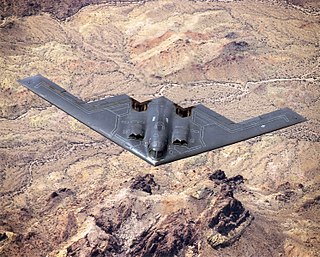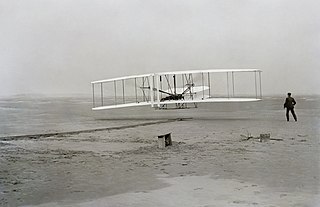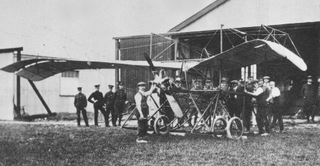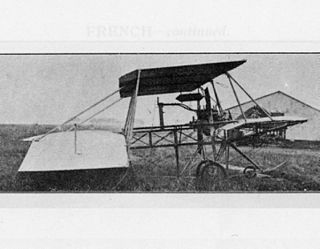
A flying wing is a tailless fixed-wing aircraft that has no definite fuselage, with its crew, payload, fuel, and equipment housed inside the main wing structure. A flying wing may have various small protuberances such as pods, nacelles, blisters, booms, or vertical stabilizers.

John William Dunne was a British soldier, aeronautical engineer and philosopher. As a young man he fought in the Second Boer War, before becoming a pioneering aeroplane designer in the early years of the 20th century. Dunne worked on automatically stable aircraft, many of which were of tailless swept wing design, to achieve the first aircraft demonstrated to be stable. He later developed a new approach to dry fly fishing before turning to speculative philosophy, where he achieved some prominence and literary influence through his "serialism" theory on the nature of time and consciousness, first set out in his book An Experiment with Time.

In aeronautical and naval engineering, pusher configuration is the term used to describe a drivetrain of air- or watercraft with its propulsion device(s) after its engine(s). This is in contrast to the more conventional tractor configuration, which places them in front.

The Handley Page HP. 75 Manx was a British experimental aircraft designed by Handley Page that flew test flights in the early 1940s. It was notable for its unconventional design characteristics, being a twin-engine tailless design of pusher configuration.

The Armstrong Whitworth A.W.52 was an early flying wing aircraft designed and produced by British aircraft manufacturer Armstrong Whitworth Aircraft.

The Short SB.4 Sherpa was an experimental aircraft designed and produced by the British aircraft manufacturer Short Brothers. Only a single example was ever produced.

Pterodactyl was the name given to a series of experimental tailless aircraft designs developed by G. T. R. Hill in the 1920s and early 1930s. Named after the genus Pterodactylus, a well-known type of pterosaur commonly known as the pterodactyl, all but the first were produced by Westland Aircraft Ltd after Hill joined them.

In aeronautics, a tailless aircraft is an aircraft with no other horizontal aerodynamic surface besides its main wing. It may still have a fuselage, vertical tail fin, and/or vertical rudder.
The Dunne D.1, was an experimental tailless aircraft built in the UK in 1907. It comprised a main unit which could be flown as a glider, to which a chassis unit with power train could be added. The glider achieved a short flight in 1907. The D.1 was later rebuilt as the powered D.4, which achieved short hops in 1908.
Royal Air Force Eastchurch or more simply RAF Eastchurch is a former Royal Air Force station near Eastchurch village, on the Isle of Sheppey, Kent, England. The history of aviation at Eastchurch stretches back to the first decade of the 20th century when it was used as an airfield by members of the Royal Aero Club. The area saw the first flight by a British pilot in Britain.

The Granger Archaeopteryx is a British single-engined, tailless parasol monoplane designed and built in the late 1920s by two brothers, R.F.T. and R.J.T. Granger. The sole example built is currently under restoration for flight.

The Dunne D.8 of 1912 was a tailless swept wing biplane, designed by J. W. Dunne to have inherent stability. One example was supplied to RAE Farnborough. License-built Burgess-Dunne models were used by the US Signal Corps and United States Navy and the short-lived Canadian Aviation Corps. It was the latter's first and only warplane.

The Dunne D.7 was one of J. W. Dunne's swept wing tailless aircraft designed to have automatic stability, first flying in 1911. It was a single seat, single engined pusher monoplane developed from the unsuccessful D.6.

The Gotha Go 147 was a German experimental two-seat tailless aircraft designed in 1936 by Gothaer Waggonfabrik and Dr. A. Kupper. Two examples were built and flown. Development was abandoned before the start of World War II.

The Waterman Arrowbile was a tailless, two-seat, single-engine, pusher configuration roadable aircraft built in the US in the late 1930s. One of the first of its kind, it flew safely but generated little customer interest, and only five were produced.

The RRG Storch V was the only member of Alexander Lippisch's Storch series of tailless aircraft to be powered. It flew successfully in the year 1929.

The Dunne-Huntington triplane, sometimes referred to as a biplane, was a pioneer aircraft designed by J. W. Dunne and built by A. K. Huntington. It was of unusual staggered triple-tandem configuration and an early example of an inherently stable aeroplane, flying regularly between 1910 and 1914.

The Nieuport-Delage NiD 940 was a French, tailless, pusher configuration touring aircraft first flown in 1934. It suffered from longitudinal instabilities and despite modifications and a more powerful engine, it did not receive its Certificate of Airworthiness.

The Johnson Twin-60 was a small, two seat biplane intended for private owners. It had twin engines for safety and the performance and undercarriage designed for short and rough field use. Despite its refinements only one was definitely built
Alan Douglas Carden was a British pioneer aviator who rose to the rank of Colonel in the Royal Engineers. He gained his pilot's licence and served with the RFC in World War I, despite having only one hand.


















